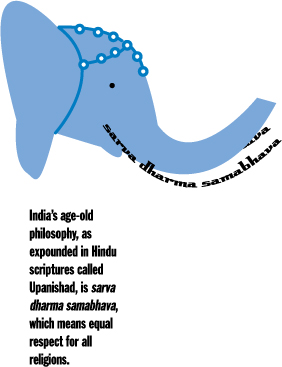|
|
|
|
SYMPOSIUM ARTICLES: Läicité and Secular Attitudes in France Secularism: The Case of Denmark The Secular Israeli Jewish Identity Secularism in Iran: a Hidden Agenda?
|
Secularism in India
India is a country where religion is very central to its people’s lives. India’s age-old philosophy, as expounded in Hindu scriptures called Upanishad, is sarva dharma samabhava, which means equal respect for all religions. The reason behind this approach is the fact that India has never been a mono-religious country. Even before the advent of Christianity and Islam, India was multi-religious in nature. India is one country where caste rigidity and the concept of untouchability have evolved and still play a major role in religious, social, and cultural matters. Under the feudal system, there was no competition among the different religious traditions, as authority resided in the sword; generally, there was no tension among the people of different religions. Though occasional inter-religious controversies did arise, blood was never shed in the name of religion. Emergence of Competitive Politics However, the entire social, economic, and political scenario changed after the advent of the British rule in 19th century. Differences between the Hindu and Muslim elites began to emerge for various socio-cultural, economic, and political reasons. The British rulers, adopting the policy of divide and conquer, distorted medieval Indian history to make Muslim rulers appear as tyrants to the Hindu elite. The Hindu elite were quick to adjust to new realities and took to modern education, commerce, and industries. The Muslim ruling elite resisted the new secular education system and did not take to commerce and industry. They were thus left far behind in the race for progress. When the Indian National Congress was formed in 1885, it adopted secularism as its anchor sheet in view of the multi-religious nature of Indian society. India could not head towards Hindu Rashtra (Hindu Nation), as India was not merely a Hindu country. Prior to partition in 1947, Muslims were 25 percent of the population of the British Raj, and, in addition, there were other religious minorities such as Christians, Sikhs, Buddhists, and Jains. However, Hindu society was a highly fragmented society and far from monolithic. The Dalits (low caste people) refused to call themselves Hindus; subsequently, their leader B. R. Ambedkar adopted Buddhism in protest. After independence and partition, a large body of Muslims was left in India; hence, leaders like Gandhi and Nehru preferred to keep India secular in the sense that the Indian state will have no religion, though the people of India will be free, both in an individual and a corporate sense, to follow any religion of their birth or adoption. Secularism in India was more a political than personal or philosophical phenomenon. The Indian National Congress adopted secularism not as a worldly philosophy but more as a political arrangement among different religious communities. Thus, India remained politically secular, while its people continued to be deeply religious. Right from the British period, the main conflict in India was not between the religious and the secular; rather, it was between the secular and the communal. In the Western world, the main struggle is that of the Church with the state and civil society, respectively, but in India neither Hinduism nor Islam had any church-like structure; so there never was any such struggle between secular and religious power structures. Secularism in India means equal respect for all religions and cultures, and the non-interference of religion in government affairs. Also, according to the Indian Constitution, no discrimination will be made on the basis of caste, creed, gender, or class. Similarly, all citizens of India have the right to vote, irrespective of religion, gender, or caste. Secular and Unsecular People In India an overwhelming majority of people are religious, but tolerate and respect other religions and are thus ‘secular’ in the Indian context. Thus, the real spirit of secularism in India is all-inclusiveness, religious pluralism, and peaceful co-existence. However, it is politics that has proved to be divisive and not religion. With few exceptions, it is not religious leaders who divide but the politicians seeking to mobilize votes on grounds of primordial identities like religion, caste, and ethnicity. In the case of India, one can say by and large that it remains secular in as much as it is religiously plural and tolerant. However, there are quite active and politically divisive forces intent on creating communal pressure and widening the gaps among religious communities, thus bringing Indian secularism under threat. |

